
Canister top gas stoves are arguably the most common type on the market, being simple to use, requiring very little maintenance, and with fuel readily available from outdoor shops. However not all are made equal, with quite a range in performance, fuel efficiency, weight, price and cooking platform compatibility. The Japanese brand SOTO have been renowned for both designing and manufacturing high-quality stoves and burners for decades. Among their standout products is the well-known WindMaster, which we put to the test over Autumn and early Winter.
We liked the WindMaster so much that we featured it in our Gear of The Year 2023:
This stands out as an exceptional piece of equipment, excelling for performance in windy and cold conditions, a rapid boil time, and fuel efficiency
Weight
Looking at each part individually we have:
| Component | Weight (g) |
|---|---|
| Main Stove | 60 |
| 4-Flex Pot Stand | 26 |
| Tri-Flex Pot Stand | 5 |
| Storage Bag | 10 |
I've mainly chosen the 4-Flex setup with a stove and bag, and it weighs 96g (it's good to see that SOTO's stated weight is accurate). There are some ridiculously light non-canister top stoves out there with some unconventional and eccentric designs for those who are ultralight-obsessed. Some canister-top stoves can come in at almost half this weight too; however, bear in mind this weight incorporates a piezo lighter, and thanks to its wind performance there's no requirement for an extra windshield. You can save 21g by using the Tri-Flex Pot Stand (available separately at £8.95). By any measure, this equipment is exceptionally lightweight.
Design and Features
True to its name, the WindMaster is specifically engineered to excel in windy conditions. This may not be initially apparent as it sits tall on the gas bottle compared to many other canister top stoves, and it's not a remote canister stove that uses a low profile to protect itself slightly from the wind. However, its burner is strategically placed closer to the pot than competitors, minimizing wind interference with the flame. A small lip around the burner head serves as a built-in windshield, while the concave design of the burner offers superior wind protection compared to the flat or convex shapes of other burners.
One of the other standout features of this stove is the incorporation of a micro regulator valve system. This ensures consistent performance across a broad spectrum of temperatures. In colder conditions, when liquefied gas cools and internal pressure drops, traditional needle valve system stoves can experience a reduced gas flow, hindering cooking. The micro-regulator system, however, maintains a steady pressure in both warm and cold temperatures, ensuring reliable performance.
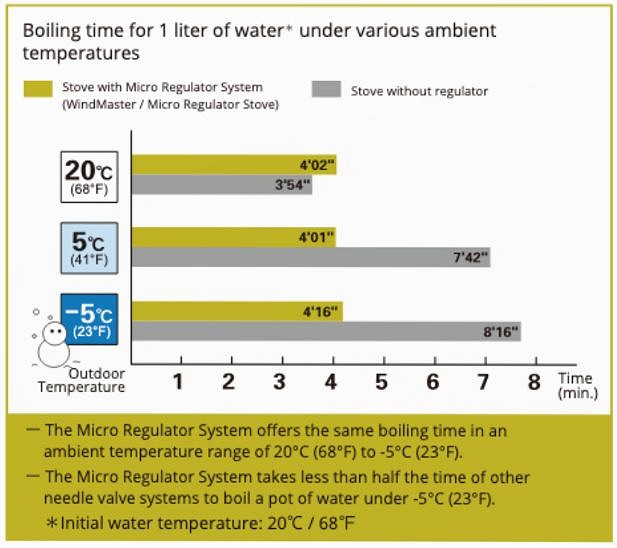
The included 4-Flex pot support clips onto the burner head, providing a spacious 14.4cm diameter for various pot sizes. For weight-conscious users, the TriFlex support offers a compact 10cm alternative. Despite a slight weight increase, I prefer the larger cooking platform, as it doesn't noticeably impact the overall pack size.
The piezo ignition is a welcome feature, especially in Scotland where winds can make using a regular lighter a bit more challenging to get a stove going with. Normally, ignitors are the first thing to fail on a stove, but SOTO claims that placing the ignitor inside the burner post will help extend its lifetime. While I haven't been able to test long-term durability, it has ignited on the first or second push so far. However, I'm not confident enough in any stove's piezo lighter to leave a spare lighter at home, recognizing the potential for unforeseen circumstances.
A small detail, but worth mentioning: the storage bag is surprisingly cheap feeling in comparison to the quality of kit on offer here. It's a bit oversized and feels like it'll probably wear out over time. It's a bit of a shame but not really a reason to put you off.
Controlled Testing
The output sits at 11,000 BTU and SOTO claims that this will burn at approx 1.5 hours using a 250g fuel canister.
A controlled test doesn't provide a comprehensive understanding of a stove's real-life performance, given that environmental factors like temperature and wind can significantly influence results, and variables in your cooking setup such as pot material, shape, pot insulation impact outcomes. Nevertheless, my less than scientific test hopefully will establish a bit of a baseline for assessing the stove's capabilities.
With my aluminium pot and full gas canister and the Windmaster at full power in an indoor setting - to ensure no wind influence - 500ml of initially room temperature water was brought to a roaring boil in just 1min 53s. Having weighed the canister before and after, I can say that the stove was able to do this using just 9g of fuel.
Next, I tested it in the most 'controlled' possible cold conditions I could devise at home. Having first placed the canister into the freezer and brought it down to roughly -5C (this won't have been the most accurate measurement) I achieved a similar boil time of 1min 55s (the canister at the end of this test was sitting at about 0C). This test again used 9g of fuel.
Given the boiling times and fuel efficiency, I've been boiling up a brew very quickly and wouldn't be worried about running out of gas too soon if heading out for any longer trip that required me to be more fuel-conscious.
In Use Performance
So what about in actual use? These quick boil times are roughly in line with what I have seen when boiling in cold conditions outside. On a particularly cold morning (I estimate closer to -10C) I could see a reduction in the stoves performance with the flame not burning quite as blue as normal towards the end of boiling a morning coffee.
Wind also impacts significantly - although it has much less of an impact than I've experienced with other canister top stoves. When I boiled 500ml of water on an exposed summit with a moderate and persistent wind, this added about 2.5 minutes to the boiling time. This may seem a large increase but I'd challenge you to find another stove that can handle conditions like this and produce a better boil time without a completely encapsulated wind barrier (designs that entail greater weight, less packability, and increased cost).
Finally, outside of just boiling water, achieving a gentle simmer with food prone to burning on the bottom in modern thin-walled lightweight pots requires a bit of finesse. This is due to the burner's close proximity to the base. Nevertheless, the micro-regulator allows the flame to remain steady and continue to burn a nice blue flame even at a low intensity, providing solid performance in challenging conditions where other burners might be extinguished. In poor conditions, having a reliable flame is preferable to having none at all.
Competition
The MSR Pocket Rocket Deluxe stands out as a direct competitor. Unfortunately, I don't have any first-hand experience with this. Both have remarkably similar designs, prioritising wind and cold temperature performance in a lightweight canister top stove. While I can't definitively predict the winner in a boil time comparison, the SOTO WindMaster seems visually better equipped to handle wind. This is due to its smaller distance from the burner head to the pot surface. The Pocket Rocket Deluxe features an integrated, non-interchangeable platform to minimize the risk of losing a component but sacrifices the accommodating diameter (or ability to swap out for a more lightweight alternative) compared to the SOTO.

Integrated stove systems such as the popular products from Jetboil and MSR will no doubt also stack up similarly or better in performance to the SOTO WindMaster, with their windproof burners and insulated pots. However, these will obviously come with a big penalty on weight, pack size, price, and pot compatibility.
Conclusion
The SOTO WindMaster stands out as an exceptional piece of equipment, excelling for performance in windy and cold conditions, a rapid boil time, and fuel efficiency regardless of the circumstances. Despite its compact size, it boasts an impressive feature set with a micro regulator and piezo igniter, all while maintaining a lightweight design. The generously sized and stable pot platform accommodates different pot or pan diameters for versatile cooking. Simmering needs a little skill due to its high-performance burner, and the non-attached pot stand introduces a potential risk of misplacement. Nevertheless, after testing I would highly recommend the SOTO WindMaster for those seeking a lightweight stove that performs in bad conditions and will also offer stable cooking with a variety of cookware.



















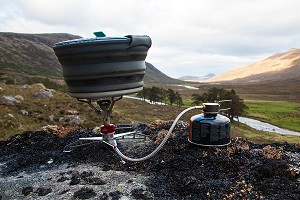
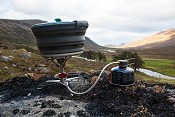


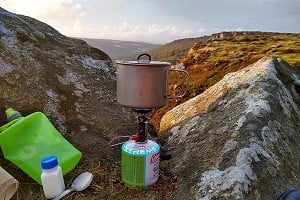

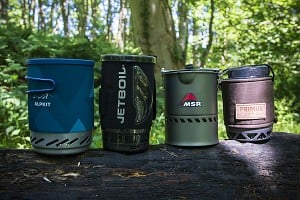

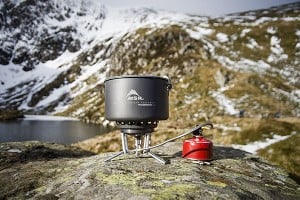



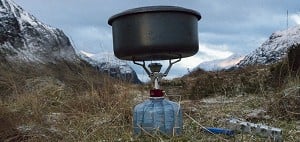

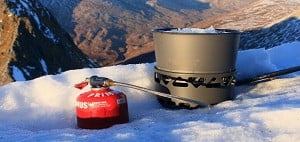





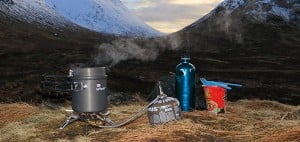

Comments
The centre of gravity of the stove seems way too high. Remote stoves seem a lot safer and more stable
Is there any info on carbon monoxide production....in past tests with stoves proximity of the burner to the pot was a risk factor for partial combustion (esp with things like melting snow), or is the flame still far enough away?
They're also a lot heavier. All design is about trade-offs and compromises.
I don't know if I'd describe 70g more as a lot heavier.
It is something that I mention in the review about being quite high. Although I have had no problems on the type of ground that I have used the stove on.
If you are ultralight concerned for a specific reason, then +70g is a lot heavier when you consider you are then close to doubling the weight of the stove at that point... Like Alan says, there is no 'perfect' stove. All have their tradeoffs.
Without a doubt this will be an excellent stove for many (including myself).